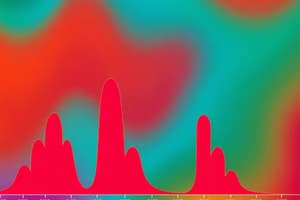Podcast
Questions and Answers
What are some benefits of representing data sets using frequency distributions?
What are some benefits of representing data sets using frequency distributions?
Organizing the data into the frequency distribution can make patterns within the data more evident.
What are some benefits of using graphs of frequency distributions?
What are some benefits of using graphs of frequency distributions?
It can be easier to identify patterns of a data set by looking at a graph of the frequency distribution.
What is the difference between relative frequency and cumulative frequency?
What is the difference between relative frequency and cumulative frequency?
- Relative frequency is the total of frequencies for a class, while cumulative frequency is the percentage of data in that class.
- There is no difference.
- Relative frequency is the average of frequencies, while cumulative frequency is the mode.
- Relative frequency is the percentage of data in a class, while cumulative frequency is the total of frequencies for that class and all previous classes. (correct)
What should be the sum of the relative frequencies after constructing a relative frequency distribution summarizing IQ scores of college students?
What should be the sum of the relative frequencies after constructing a relative frequency distribution summarizing IQ scores of college students?
In a frequency distribution, the class width is the distance between the lower and upper limits of a class.
In a frequency distribution, the class width is the distance between the lower and upper limits of a class.
Given the minimum (11), maximum (98), and number of classes (6), what is the class width?
Given the minimum (11), maximum (98), and number of classes (6), what is the class width?
What are the lower class limits for minimum 7, maximum 95, and 6 classes?
What are the lower class limits for minimum 7, maximum 95, and 6 classes?
What are the upper class limits for minimum 7, maximum 95, and 6 classes?
What are the upper class limits for minimum 7, maximum 95, and 6 classes?
What is a frequency distribution?
What is a frequency distribution?
What is the frequency (f) of a class?
What is the frequency (f) of a class?
What is the range in a data set?
What is the range in a data set?
What are class limits?
What are class limits?
What is class width?
What is class width?
What is relative frequency?
What is relative frequency?
What is cumulative frequency?
What is cumulative frequency?
Flashcards are hidden until you start studying
Study Notes
Frequency Distributions
- Organizing data into frequency distributions reveals patterns more clearly.
- Graphical representations of frequency distributions enhance visibility of data trends.
Relative Frequency vs. Cumulative Frequency
- Relative frequency represents the percentage of data within a specific class.
- Cumulative frequency is the total of frequencies in a class and all preceding classes.
Relative Frequency Distribution
- The sum of the relative frequencies in any data set should total 1.
Class Width in Frequency Distribution
- Class width measures the distance between lower or upper limits of consecutive classes.
- A false statement about class width struggles with correctly identifying lower and upper limits.
Calculating Class Limits
- Given minimum=11, maximum=98, and classes=6:
- Range calculation: 98 - 11 = 87.
- Divide range (87) by number of classes (6) to find class width of 15.
- Lower class limits: 11, 26, 41, 56, 71, 86.
- Upper class limits: 25, 40, 55, 70, 85, 100.
Specific Example of Class Limits Calculation
- Given minimum=7, maximum=95, and classes=6:
- Class width is determined to be 15.
- Lower class limits established as: 7, 22, 37, 52, 67, 82.
- Upper class limits determined as: 21, 36, 51, 66, 81.
Definitions
- Frequency Distribution: A table displaying intervals of data entries per class.
- Frequency (f): The number of data entries within each class.
- Range: The difference between maximum and minimum data values.
- Class Limits: The smallest and largest values designated to each class.
- Class Width: The distance between the lower or upper limits of each pair of consecutive classes.
- Relative Frequency: The proportion or percentage of the dataset in that class, calculated as (class frequency)/(sample size).
- Cumulative Frequency: The total of class frequencies including all prior classes.
- Midpoint of the Class: The value falling halfway between the class limits, providing a center for each class.
Studying That Suits You
Use AI to generate personalized quizzes and flashcards to suit your learning preferences.




